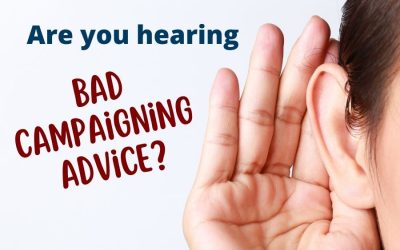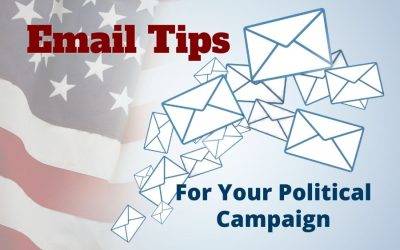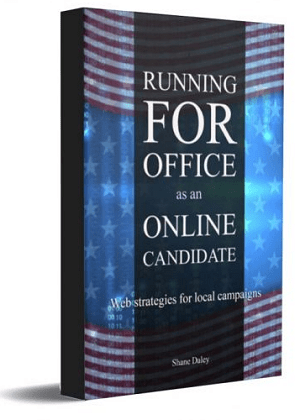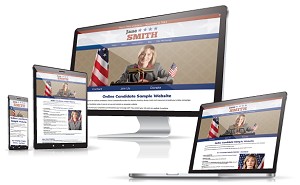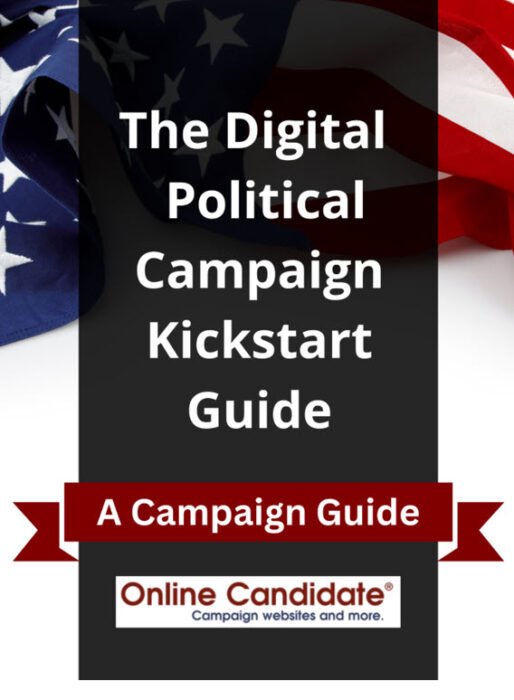How Much Should You Doctor Your Candidate Head Shots?
Most political campaign websites include a photograph of the candidate in the site header. It’s usually a head shot along with a logo and usually some sort of background image symbolically related to the location.
Often when we get a head shot in preparation for designing a campaign website’s header image, a client may make a comment about the image, such as ‘the color is off’ or ‘I look too wrinkly’. Even if nothing is said about the photo, we do our best to make the head shot look as attractive as possible.
In other words, we doctor the image. After all, you wouldn’t go on television without makeup. Why wouldn’t you enhance an important online photo?
We usually crop out backgrounds from the head shot, unless the background is included within the website header. We’ll also do color correction and sharpening to make the image crisper. In some case we’ll go a bit further in smoothing a few wrinkles or reducing dark rings or puffiness from the eyes. But it’s subtle. With the wonders of digital graphic design, we could easily knock off twenty years from someone’s appearance. A lot a clients might like that idea, but that’s probably going too far.
Just because we can replace your receded hairline or brighten your teeth to ultra-white doesn’t mean it’s a good idea to do so. You’ll still want voters to recognize you in real life.

This is NOT how to properly touch up a head shot. It shouldn’t look like it went through an Instagram filter.
Most web photographs need to be cropped, sharpened and color corrected. However, we do NOT advocate full-scale alterations that may create misrepresentation. For example, fully replacing one person in an image with someone else or superimposing subjects that were not in the original image. Fraudulent edits can come back at you, especially if someone finds the original photo and compares it to your altered image.
Sometimes alterations may include removing something from clothing. For example, many sheriff candidates are not allowed to display their badges, patches or official seals on political material. In those cases, we may digitally remove or replace those items.
To sum it up: A little nip and tuck on a candidate’s photo is fine. Interior images can also be cropped and enhanced, but the basic content should remain unaltered. (Blurring faces for privacy is all right, though.)
Candidate photography head shot tips:
- Consider having your photographs done professionally. One session with a photographer might be all you need. If this is not possible, use a good digital camera with proper lighting.
- A head-on or three-quarter view is typical.
- Avoid plaid or tight-patterned clothing.
- The best shots for site headers are those where the candidate is standing before a solid contrasting background to what the candidate is wearing. This allows the background to be more easily cropped out.
- A large, high resolution is best for a graphic designer to work with. Large-sized images can be scaled down, but small, low-res images cannot be improved much.
- Dress appropriately.
- Smile!
Related: Tips for Great Political Campaign Photography
For more political marketing ideas, download our e-book Running for Office as an Online Candidate. This is available individually or as part of our Combo Package.
9 Tips For Better Online Fundraising
Online fundraising has grown tremendously in the last decade. Campaigns and nonprofit organizations today can raise money with the click of a mouse or a tap of the phone. But raising money requires planning and skill. It’s not enough to just have a website donation page or a Facebook profile.

Tips to get the most from your online fundraising efforts:
Always the “Ask”. When you send emails or activist alerts to supporters, don’t bury the ask. In other words, state what you want the recipient to do – give money, attend an event, show up at the polls, etc. If you don’t ask for what you want clearly and prominently, you won’t get a great response.
Ask everywhere. Make the ask on your campaign website, in your emails, social media in your email signature – and offline, as well. It’s good for recipients to hear your message from many channels.
Specific monetary requests perform better. It’s easier to raise money for a specific need. They work even better when coupled with urgency. “Please send $25, $50 or $100 to help us complete our final GOTV mailing. Our printer deadline is in three days!”
Use landing pages that match your request. If you are using email, online advertising or social media to drive traffic, make sure that the landing page corresponds to your message. For example, if you are advertising for GOTV, don’t send visitors to your website home page. Instead, create a new page that explains your get out the vote needs and how visitors can help by volunteering to drive, poll watch, etc. A good landing page will reduce exit rates and improve response levels.
The money is in the list, so keep building it. Build your campaign email list both online and offline. Encourage email signups wherever you can. Even use offline events as a way to get people to sign up for your email list.
[bctt tweet=”If you don’t clearly ask for the #donation, you won’t get a great response. http://ow.ly/Oadb30gBm34″]
Tell your story. Combining appeals for support with a strong, compelling (and heartfelt?) story can help bring home your message or appeal. It doesn’t need to be long, just memorable. Done well, voters will associate your stories with your name, in a positive way.
Images and video help influence response. Good visuals attract attention and can help drive home your point. There are online tools that make it easy to create images for social media and email purposes.
What’s in it for them? Why should someone support you or your campaign? People often act out of self-interest. Give them concrete reasons why their support not only helps you but will help them as well. Micro-targeting your recipients by specific issues can provide self-serving reasons to support you.
It’s not all online. Even though online campaigning has increased rapidly in the last few years, don’t let it come at the expense of traditional methods. You still need real events and to leverage your personal contacts. Combining online and offline strategies will help you raise more money for your organization.
Related: Comparing Political Donation Platforms – Our Recommendations
Start raising more money online with Online Candidate. Easy to start, easy to use, featuring the tools you need for online campaigning. View our packages for political websites.
The Worst Advice We’ve Heard About Online Campaigning
Even though there is plenty of good information about politics and online marketing, a lot of bad ideas persist. Here are some truly bad assumptions about political campaigning. Some are misconceptions about online marketing, while other assumptions can hurt your election chances.
“The more social media followers I get, the more people can keep up with my campaign.”
 Social media followers are great, but to get followers for the sake of getting followers is a fool’s errand. For one thing, not everyone uses social media, so you are broadcasting your message to a gated audience. Second, not everyone will see your messages. In Twitter, tweets flow in a constant stream. On Facebook, you can count on less than 10% of your followers actually seeing an update – unless you decide to pay to promote that post.
Social media followers are great, but to get followers for the sake of getting followers is a fool’s errand. For one thing, not everyone uses social media, so you are broadcasting your message to a gated audience. Second, not everyone will see your messages. In Twitter, tweets flow in a constant stream. On Facebook, you can count on less than 10% of your followers actually seeing an update – unless you decide to pay to promote that post.
Social media isn’t ‘free’ anymore – not in time or money. If you want to keep interested people in the loop, focusing on building your email list and texting efforts.
[bctt tweet=”Social media isn’t ‘free’ – not in time OR money. http://ow.ly/eAgv30gBkca”]
Another problem with going too deep too soon in social media is that you can get stretched too thin. Try to keep up on too many platforms, and you can be in danger of burning out fast. It’s better to start with what you can handle and grow with your available resources.
“I’m going to wait to start campaigning online until I have the money.”
That’s the old ‘chicken and egg’ question in online campaigning. Once you have a campaign bank account, the ability to raise money online is simple. Many people today prefer to donate online. Starting a website does not cost much money, and it’s an investment that can pay for itself with just a few donations.
Our advice for local campaigns is to start small, use your online platform to raise money, and use that money to build your online marketing efforts. Time is not on your side in an election. The sooner you get started, the better.
[bctt tweet=”Time is not on your side in an #election. The sooner you start preparing to run, the better. http://ow.ly/eAgv30gBkca”]
“I need to my domain and website running right away because I have already started my campaign and have print materials ready to go out.”
This issue comes up sometimes, and while our turnaround on websites is very fast, there isn’t a thing we can do if a client wants a domain that already registered by someone else. Domain names can be registered long before a website for a candidate is built. It’s a good idea to secure your domain as early as possible, because you cannot assume that name will be available later.
It’s seems obvious, but under NO circumstances should you print campaign brochures and materials with a domain name on it unless you already have a website ready for traffic.
“I just want a big image on my splash page… By the way, my website isn’t showing for searches of my name.”
Oh, boy. This comes up a lot. While having a splash page or large image on the home page may look great for humans, it doesn’t do much for search engines. Search engines cannot read images very well. If you want to have any search rankings, then you need to give the the search engines enough copy to read so they know what your site is about. How you write your text is important, so make sure you mention the candidate’s name, location, and elected position within in your home page copy.
“I’m going to let the website and domain go. I’ll start back up in the next election cycle.”
A lot of candidates and campaigns decide to shut down their website after the election. If they’ve lost, maybe they are done with politics forever. If they’ve won, they often don’t see the need to keeping a website until the next election. Unfortunately, shutting down a site puts a big hole in your online presence. All those links and articles that point to your website will be broken. The rankings you have for your name will disappear. And if you let your domain name expire, someone else will be free to register and use it for different purposes.
Even if a client wants to shut everything down, our recommendation is to at least keep your domain name active – especially if the domain includes the candidate’s name. Keeping a domain name is a nominal expense, and it keeps open the possibility of restarting another site with the same name.
And the bad ideas don’t end there…
There are a lot of misconceptions to political online campaigning. That’s part of the reason why we created the blog on this site. A lot of new candidates don’t really know much about the online world – and that can hurt their chances of willing. A little education goes a long way.
Image courtesy of FreeDigitalPhotos.net
The Toughest Job for Any Political Candidate
The hardest thing about running for office is asking for money. Unless you are independently wealthy or have generous benefactor, you will need outside financial sources to get your political campaign off the ground.
The cost of election campaigns is high. In 2019-2020, congressional candidates collected $1.4 billion and spent $806 million dollars. State races are reaching new heights of spending, as well.
Depending on the size of the area and competitiveness, even local elections for city council, school boards and local bond initiatives can become costly. Campaigns require multiple ways to reach and communicate their message to voters.
Your own race will likely have expenses that include:
- Yard signs and billboards.
- Direct mail printing, mailing and distribution costs.
- Advertising in newspapers, radio and local cable.
- Voter data information.
- Online advertising for social media platforms like Facebook.
- Phone bank and texting outreach.
- Promotional activities and events.
Larger campaigns may also incur costs for staff salaries, office space, travel and accommodations.

Better funded candidates typically win their elections.
Asking for campaign money is the primary way to fund these activities. It’s also the most difficult part of any campaign. This can be even more challenging if your opponent has more financial resources.
If you’ve never had to ask someone for money before, it can be a difficult and intimidating experience. It’s even natural to feel guilty or a little bit dirty asking people to donate to your campaign.
For most candidates, it’s the worst part of the campaigning process.
But remember that the money you are asking for is not for yourself. You are asking people community to invest in something positive, to support political communication to achieve a larger goal.
The reasons you may be running might be:
- To create change and make a difference
- To improve the living standards of your community
- To provide better representation for constituents
- To serve the voters of your district.
These issues are why people should vote for you, and why those who back you should be donating to your campaign committee.
As hard as it may be, you’re asking for help with something constructive for your community.
If you can find others who agree, and have the means to give, then you can help them be a part of something bigger than themselves.
And that should make you feel better about raising money. Make your request as part of your story and tie it in with each potential donor’s specific interests. Be specific with what you’d like them to do and transparent as to how their contribution will help.
Unless your districts is very small, you will not be able to successfully reach voters and win without advertising. And advertising costs money, which is why you will end up spending a lot of time working the phones, meeting people in person, sending email, and mailing postcards
In some cases, you may have outside political groups, PACs, or single-interest organizations may decide to contribute or assist your cause, but you can’t count on that.
In the end, you can’t be afraid to ask for money. In many ways, the process is even easier than in the past. Rather than asking for a written check or a cash contribution, online donation platforms simplify tracking and reporting. (Your treasurer will thank you, too!)
If you are thinking about running for office and want to win, you should start considering how you plan to raise funds.
But with the right mindset, doing it might not be so rough.

Save time and effort with our Campaign Letter Templates or save with our Combo Packages.
Primary vs. General Elections: Tailor Your Digital Campaign for Success
In the United States, there are two types of election campaigns: the primary and the general. This article explains their differences and how they affect your digital strategy.
A primary election is an election of one or more candidates of a particular party seeking an elected office. Regular State Primary Elections are held on even years in the month of August. Special primary elections occur when required. The winners of the primary election go on to run in the general election. In some states, only members of a particular political party can vote in a primary. In other cases, only people who live in a certain district may be able to vote. On the other hand, all eligible voters are allowed to participate in general elections.
A general election is where voters of all parties participate, and all voters decide the final winner to hold elected office. This will include the winning candidates from the Republican and Democratic primaries. General elections are typically held in November, though local elections may occur at other times throughout the year.
- What are primary elections?
- How is an open primary different than a closed primary?
- What is the biggest difference between a primary election v general election?
- Primary election strategies for local office
- You’ve won your primary – Now what should you do?
- Boost your online campaigning efforts
- FAQs
What are primary elections?
Primary elections are held by political parties to choose their nominee for the general election. Voters are typically limited to vote only for the primary of their own party. Republican voters can only vote in Republican primaries. Democrats can only vote in Democratic primaries. Another difference is that a primary is only between candidate’s of a single party, while a general election occurs between opponents of different parties. For local campaigns, winning the primary is just the first step; you must then adjust your message for a more diverse general electorate.
The purpose of a primary is for party members to nominate one or more candidates for the general election. If there are multiple candidates from a political party running for office, a primary is a way to narrow the field of candidates. A primary election can also be used as an opportunity to elect political party officers. Primaries serve as a testing ground to gauge which issues resonate with your party’s core supporters.
In the United States, each state has its own rules and regulations governing how a candidate is allowed to run for office.
How is an open primary different than a closed primary?
The difference between an open and a closed primary election comes down to who is allowed to vote. In an open primary, any registered voter can cast their ballot in either party’s primary. In a closed primary, only voters registered with a particular party are allowed to participate in that party’s primary. Eleven states – Delaware, Florida, Kansas, Kentucky, Maine, Maryland, District of Columbia, Nebraska, New Mexico, New York, Pennsylvania, and Wyoming – have closed primaries for Democratic or Republican candidates.
For example, if you live in Texas, which has an open primary system, you can choose to vote in either the Democrat or Republican primary. However, if you reside in New York, which has a closed primary system, you can only vote in the primary of your registered party. Closed primaries often yield a more ideologically uniform electorate, while open primaries may bring in crossover votes that can alter the dynamics of your support base.
There are also semi-closed primaries that allow unaffiliated (independent) voters to participate. Depending on the state, independents either choose the party primary they want to participate in the voting booth or by registering with a party on Election Day. Fourteen states have semi-closed primaries that allow voters to register or change party preference on election day.
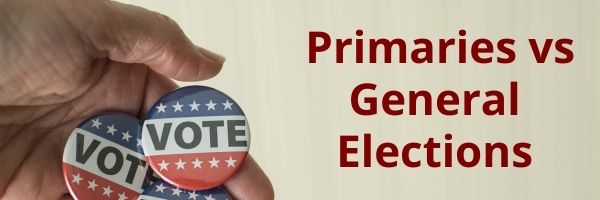
There are major differences between a primary and a general election
A primary election is a method of choosing a party’s nominee for an upcoming general election. One difference between a primary versus a general election is that general elections tend to have a higher voter turnout than primaries. This means that while a primary win demonstrates strong support among party loyalists, success in the general election depends on appealing to a broader, more diverse electorate.
In recent national elections in the US, about 60% of the voting eligible population votes during presidential election years. But only about 40% votes during midterms. Turnout tends to be lower during odd years, both for primary and general elections. Turnout variations may be even more pronounced due to community-specific issues and local election schedules.
A general election tends to have a higher voter turnout than a primary.

Primary campaign election strategies
To win office, even local candidates sometimes need to campaign twice: Once in the primary, and again in the general. That’s twice the work for just one election.
Winning a primary election is largely determined by nature of your primary. Your campaign strategy will be influenced by a number of factors. For example, is there an open seat? Are you running against a strong incumbent? Factors include how long the incumbent has been in office, their general popularity and if they have particular weaknesses of which you can take advantage. Local factors such as community issues, historical voting patterns, and district-specific regulations also play a significant role.
What is the nature of your local election laws? For example, in a three or more candidate primary, the rules might make it a ‘winner take all’. The person with the most votes wins, even if it isn’t 50% of the votes. There are municipal races for town or city council where the candidates that garner the most votes win the open seats.
What if you don’t reach a 50 percent threshold?
In other cases, there may be a runoff in which no candidate get 50% + 1 votes. (How will you deal with that possibility?) A primary runoff is a second primary election conducted to determine which of the top vote-getters in the first primary will be awarded the party nomination for office.
- Figure out how many votes you need to win. Once you do that, you’ll need to put together a solid campaign plan. This will encompass your positions, how your staff is arranged and how you will use your volunteers. To increase your chances of winning a primary race, you should build up your primary voter list early.
- You’ll also need to raise money. Most local campaigns are small and do not have a lot of resources. A good chunk of your plan should be how to initially fundraise and expand you donor base.
- Print advertising is expensive. Many local campaigns use the internet to attract and target primary voters. The cost to entry is low. Having a campaign website and creating an active online presence lends legitimacy that you are a serious candidate to primary voters. Use Facebook, Twitter and email as part of your digital strategy.
- Reach out to absentee voters. In many instances, primaries attract a large number of absentee voters. Because absentee voting is popular, candidates who have an an online presence to reach out to voters have an advantage over opponents who do not.
You’ve won your primary – now what should you do?
Candidates work hard to secure a primary victory before they shift their campaigning for the general election. Many times, candidates may delay broader outreach until after securing the nomination. For example, you may be running unopposed in your party. Because of this, you may find little reason to put resources into early voter outreach. You might assume that once you’ve won the primary, the race is effectively over. However, building relationships with the wider community from the start is critical.
General elections tend to have a higher voter turnout than primary elections. Even if a candidate is a shoo-in for a primary win, they still need to motivate those primary voters to show up for the general election – especially those who did not vote for the candidate in the primary. Then it’s a matter of getting enough total votes to win.
Remember, the shift from a partisan primary to a more inclusive general election means you must adapt your message to resonate with a diverse electorate.
Boost your online campaigning for exposure
Digital outreach is a powerful way to influence supporters, raise donation money and motivate voters. If you are not leveraging the web, then you are missing a huge opportunity to engage voters.
These days, we are seeing candidates starting their online campaign efforts more than a year out from Election Day. They might not be actively campaigning, but they are laying a foundation for election season. They are starting social media accounts, registering domain names, building campaign web sites, growing their email list, and preparing to accept online donations.
With a solid campaign strategy in place, it’s essential that your online presence reinforces your message and reaches your target audience.
Starting early is critical to building support. If you wait too long, you may find yourself playing catch-up on the home stretch to Election Day.
Frequently Asked Questions
How can candidates transition their digital strategy from a primary election focus to a general election focus?
Candidates need to adapt their digital strategy when moving from a primary to a general election. The focus shifts from appealing specifically to party members to reaching out the wider electorate. This involves understanding the broader concerns and issues of the race. To win, messaging should be inclusive and address the needs of all voters, not just those of a specific party.
How can candidates leverage voter information to refine their digital strategies?
Analyzing and leveraging voter data is a major part of any digital strategy. Candidates can use data to identify trends or specific voter preferences and concerns. This data is how campaigns can create and leverage targeted communication. For example, social media ads can be customized to address local issues relevant to specific voter groups. Even email campaigns can be segmented and personalized for better engagement and support.
How should candidates adjust their messaging when moving from a primary to a general election campaign?
Second, candidates might also adjust their tone. During a primary, the tone can be more about rallying the base with strong, partisan language. In a general election, the tone often becomes more inclusive and moderate. The goal is to attract undecided voters and perhaps even those from the opposing party who do not support their own party’s candidate. Often a shift involves emphasizing unity, legislative bipartisanship, and a candidate’s willingness to work across the aisle to solve common problems.
Online Candidate provides an easy and affordable way to build your online presence. Learn more about our political website packages and services for marketing your campaign.
Top Tips for Your Political Email Marketing
Political campaigns are always looking for new ways to reach out to potential voters. They are usually short on time, money, and resources, but they don’t want their message lost in the noise of the election season. This is why many marketing techniques that work well for businesses can be used successfully in political campaigns.
Email marketing is one of the most powerful tools for political organizations to reach out to voters and supporters. It is one of the most effective forms of marketing because it can reach a large number of people at once.
In this article, we’ll talk about some of the best ways to use email marketing for politics.
Political email marketing raises large donations
Political email marketing is a subset of digital marketing that focuses on the use of email to promote political candidates, issues, and voter turnout. In larger campaigns, political email marketers are often guided by campaign managers or digital directors.
Political email has been around a long time now. Even as far back in 2005, 6% of internet users signed up for US presidential candidate email alerts.
The goal of fundraising campaigns is to get people to donate money. The more money they can raise, the more likely they will be successful in their campaign.
Email is a very important tool in this process. It’s not just presidential candidates who raise big money. State and even local candidates are effectively leveraging the power of email. While it is often used to solicit donations for campaigns, email can also be used to promote events, rallies, and other political activities.
A successful fundraising campaign is one that doesn’t just ask for donations, but also provides a compelling reason for why people should donate. To do this, it might be helpful to provide some context about the situation and what could happen if no action is taken.
Best practices for successful campaign emails
Email marketing services are an easy way for political campaigns to reach out to potential voters and make sure they are up-to-date with the latest information about their candidate or cause.
Here are a few best practices that can help you create successful political email campaigns.
- Keep it simple. Make sure that each message is simple and easy to understand. Keep in mind that it should be something that everyone can relate too, not just those who are already on your side.
- Focus on the voter, not you. When crafting your emails, try to take the focus off of yourself and put it on your reader.
- Use emotional triggers to motivate your audience. It has long been understood that emotions are the driving force behind human action. According to neuroscientist Antonio Damasio, 95% of decisions are based on emotion rather than logic. Emotion, over logic, often motivates people to take action.
- Create a call-to-action at the end of your email for the reader to take. Ideally, you should limit your call to action to one per message.
- Make sure that you are sending emails at the right time. If you are sending emails too late in the evening, it will be easier for people to delete them without opening them. Sending an email in the morning or early afternoon will increase your chances of getting a response from your audience.
- Do not send too many messages too often, otherwise people will start unsubscribing from your list because they feel overwhelmed. How many emails are too many? That depends on the message and timing. Sending a few messages a day before an election or primary might not be too much. Emailing multiple times a day six months out could annoy your subscribers.
The success of an email list depends on how well it is curated. Many campaigns segment subscribers into different groups, so that people can be targeted with relevant content and messages that are specific to their interests.
Related: The Money Is In The List – Have You Started Yours?
Top topics for political email newsletters
 You have a campaign newsletter – and you’re even gaining subscribers. Great! From now until the election, you will need to keep your supporters informed and involved.
You have a campaign newsletter – and you’re even gaining subscribers. Great! From now until the election, you will need to keep your supporters informed and involved.
There are two main types of political emails: fundraising and persuasive. Fundraising emails are used by campaigns that have already been established as a viable candidate, while persuasive emails are used by those who want to promote themselves as a viable contender.
Here are topics to keep your campaign emails interesting:
- Recent campaign events: Keep your supporters up-to-date. Don’t forget to include (or link to) photos, press releases and other material related to the event.
- Dates to be aware of: Voter registration deadlines, fundraising deadlines for donations, official voting polls open and close times for the primary or election.
- Information about your opponent. Point out laws or legislation that your opponent has supported or voted for. Use this to contrast your own positions.
- Information about upcoming events: Provide a list of upcoming events, but keep the list short. Save more future events as subject matter for additional newsletters.
- Campaign staffing or supporter news: Mention new citizen groups or where that new, extra-large billboard ad was posted. Let your readers know just how wide your support really is.
- New additions to your website: From new policy papers to photos from the latest campaign event, don’t forget to mention them!
- Endorsements: List endorsements from prominent individuals and organizations. Be sure to add a blurb or two as to why they are supporting your campaign.
- Position statements: Use the opportunity to state your position on an existing issue, new issue or current development.
- Requests for volunteer and financial support: For better response, try to combine fundraising pushes with a specific need or goal.
The best content for any communication should be relevant, timely, and interesting.
Finding the right political email vendor
There are many features to consider when choosing the best email marketing software. These include the price, functionality, and usability. For example, while some offer a free trial, others charge a monthly fee. Some email marketing services offer advanced analytics and segmentation tools while others specialize in social media integration or real-time reporting options.
Here are a few email marketing services that many of our clients use:
- AWeber.com – Free to use. Includes features like autoresponders and split testing.
- MailChimp.com – Free for up to 2,000 addresses. Limited features and send ability with free plan.
- MailerLite.com – Free for up to 1,000 addresses. Includes a library of app integrations.
While free packages are fine for local candidates running for town council, sheriff or school board, state-wide and congressional campaigns often have larger subscriber numbers. They often require paid services.
You can integrate your email signup forms into your Online Candidate website. We also offer optional Aweber or MailChimp account setup for our website clients.
Using automated email messaging for constant supporter contact
Email sequences are a way to organize messages in a series that are sent to the same person or group of people. An email sequence is a series of emails that are sent to subscribers with the intention of nurturing the relationship. The sequence can be as short as three emails or as long as six.
The first email in the sequence is usually an introduction that includes information about the candidate or organization and why the campaign is important. The second email should include more details about the campaign and how supporting the candidate will help the voter. The third email can be where you ask for the reader’s response and provide a relevant call to action, such as volunteering to help or making a donation. Other messages can be about the candidate and where they stand on important issues.
You can set up email automation with many messages. Keep in mind that those messages are automatically sent, so the content should be independent of timing. You should modify or turn off any settings for time-based delivery after Election Day.
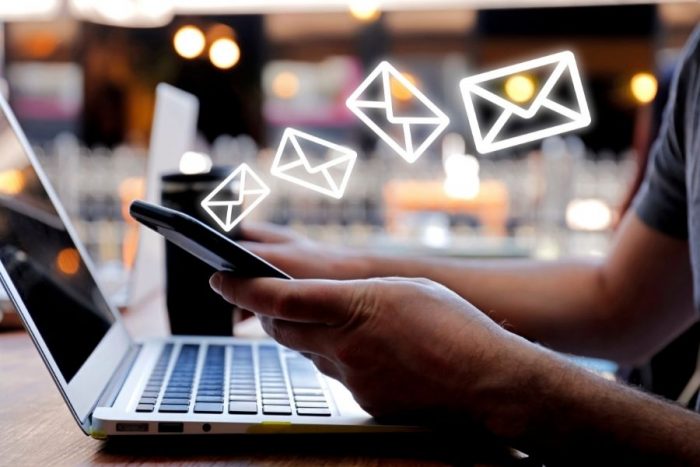
The spam problem – can it apply to politicians?
Most people don’t like receiving unsolicited email. To avoid being seen as spam or being reported as spam, you need to have permission from your recipients before sending them emails. You can get people to sign up for your email list through your political campaign website, your social media accounts, and even offline. You can have attendees at events provide their email addresses, which you can later add to your list.
The goal of an email marketing campaign is to increase the number of people who opt-in to receive messages from your company. This is important because it will help you avoid being classified as spam.
There are many reasons why your email may be classified as spam, including the following:
- Your content isn’t engaging enough for people to want to read it. Your messages don’t get opened, signaling to some email hosts that the message may be unwanted.
- You’re sending too many messages that are similar in content or frequency, which can lead recipients to unsubscribe or mark your messages as spam.
While CAN-SPAM covers e-mails promoting commercial products or services, a poor open rate or high unsubscribe rate can have a negative effect on your own deliverability. This means that your emails might not be delivered to the inbox of the recipient or filtered to a junk mail folder.
Faqs
How do you measure the success of a political email marketing campaign beyond open and click rates?
To measure the success of a political email marketing campaign, look beyond open and click rates. Consider conversion rates, such as donations made, event sign-ups, or volunteer registrations. Analyze email forwarding rates to gauge message resonance. A/B testing between messages will you refine subject lines and find out what content really resonates with subscribers. Track unsubscribe rates to manage list health.
What are the legal considerations and compliance requirements for political email marketing?
Legal considerations for political email marketing vary by region. In the U.S., the CAN-SPAM Act outlines requirements for commercial emails, which can apply to some political messaging. Ensure you have explicit consent to email recipients. Always provide a clear opt-out mechanism. For international campaigns, be aware of stricter laws like the GDPR in Europe, which demands rigorous data protection measures.
How can political campaigns effectively segment their email lists to tailor messages more personally to different groups of voters?
Segmenting political email lists improves messaging personalization. Start by collecting subscriber data. This can be through the sign-up forms, where you may ask for interests or location. You can also segment by engagement as to how often or what types of messages subscribers open. This information can be used to create segments, or groups of email addresses. Tailor messages to each group’s interests and behaviors. For example, send targeted policy updates to those interested in specific issues. Personalized emails tend to have better open rates and engagement.
Conclusion
Email marketing is a powerful way to reach voters and potential supporters. It enables campaigns to send out personalized messages in an inexpensive, timely, and scalable way. It is one of the most cost-effective channels for getting in touch with supporters and potential voters.
Want to learn more about digital campaigning? Find more ideas and tactics in our book, Running For Office as an Online Candidate.



